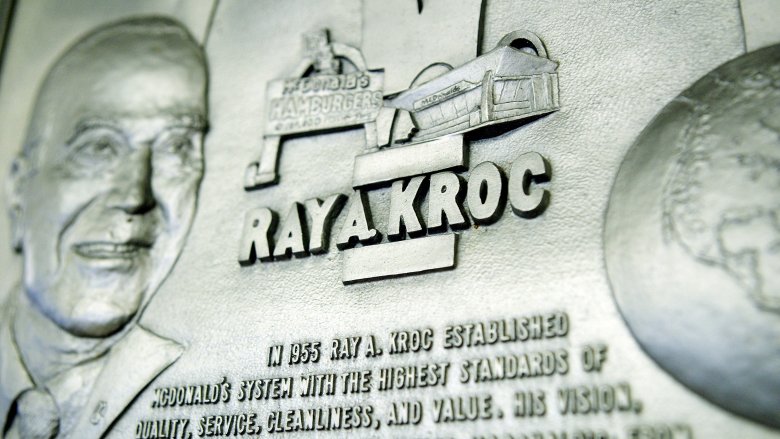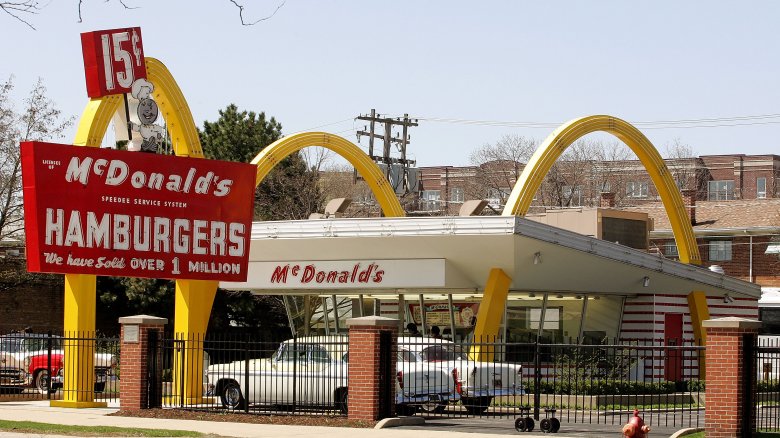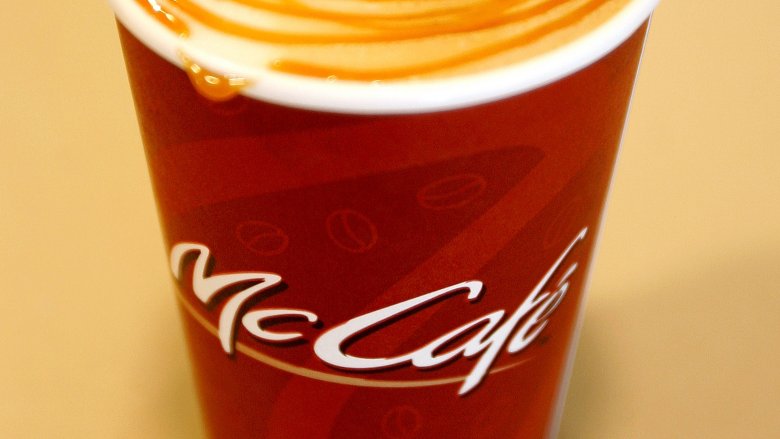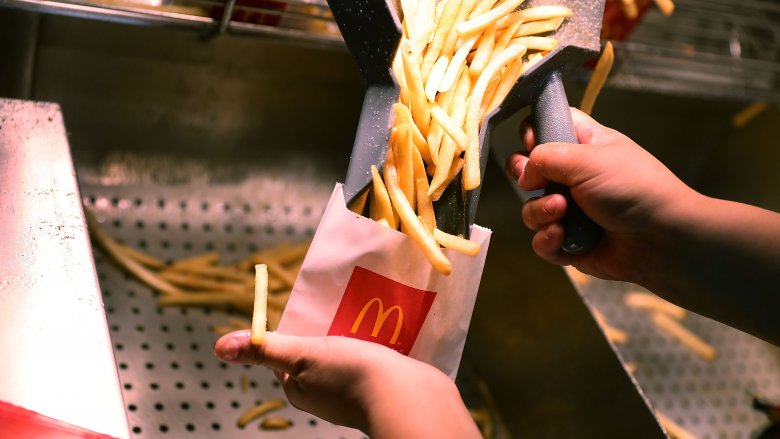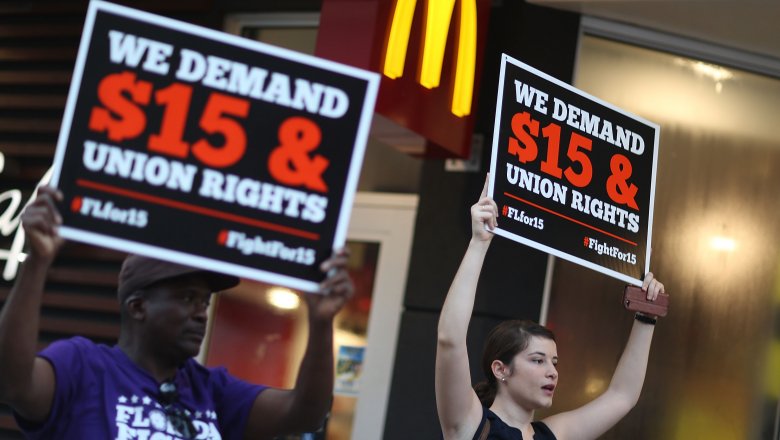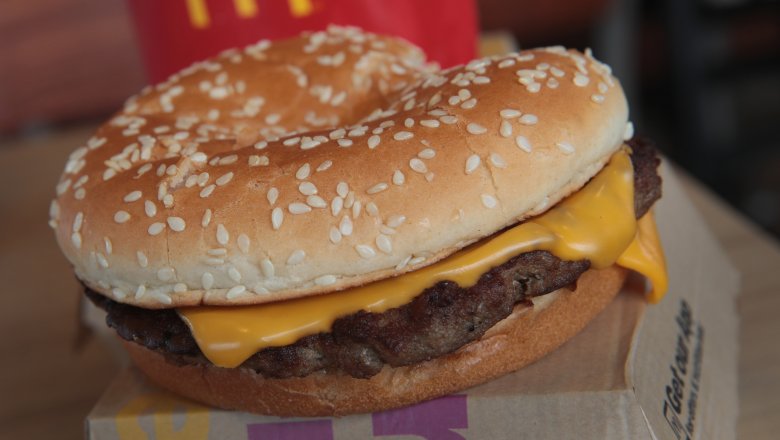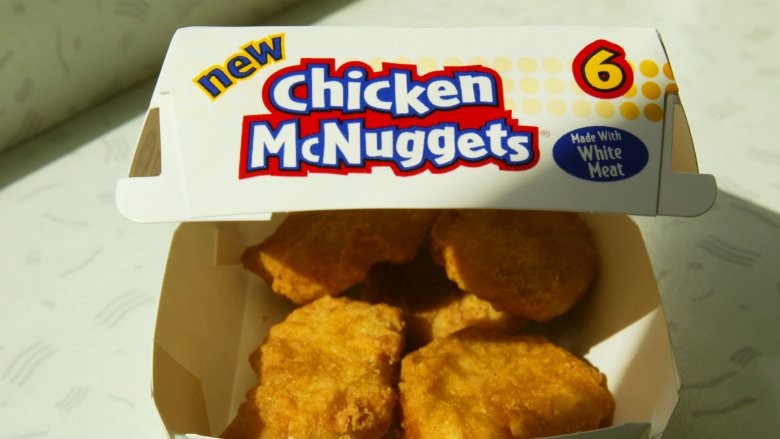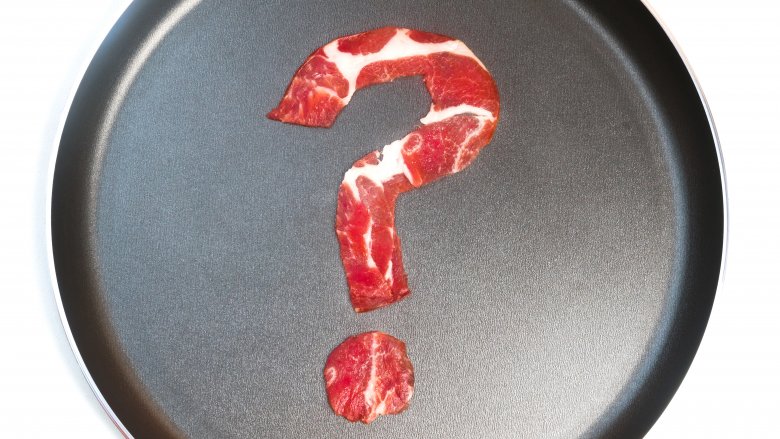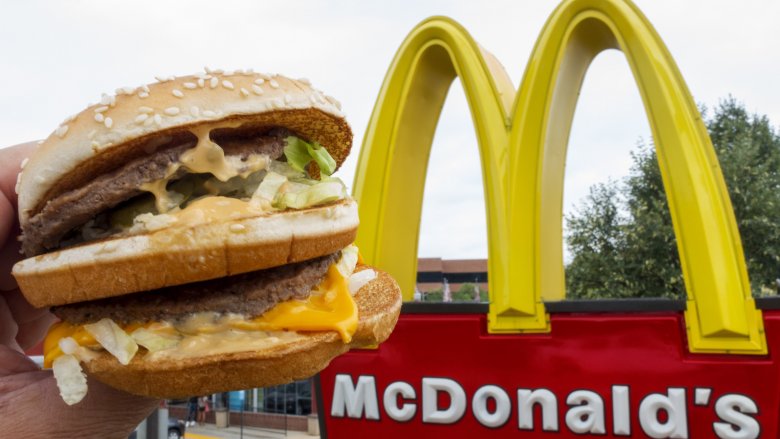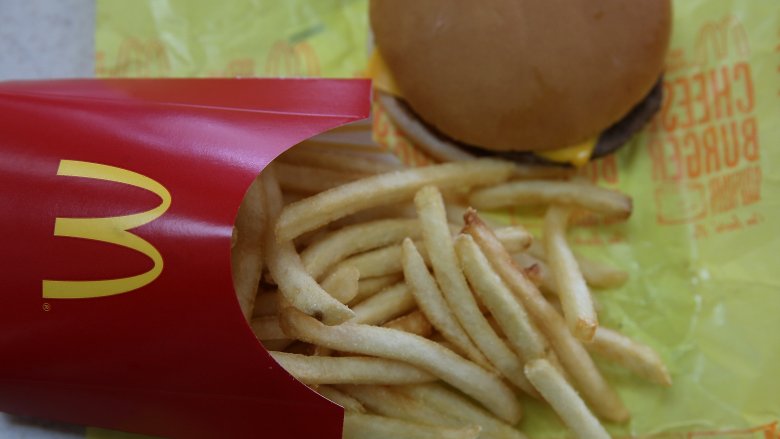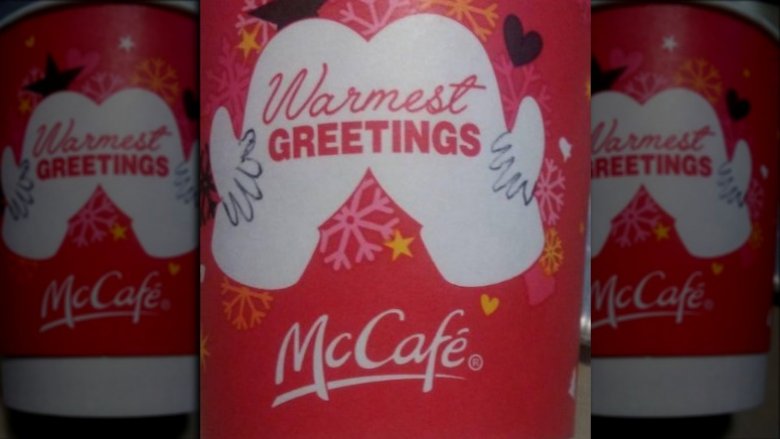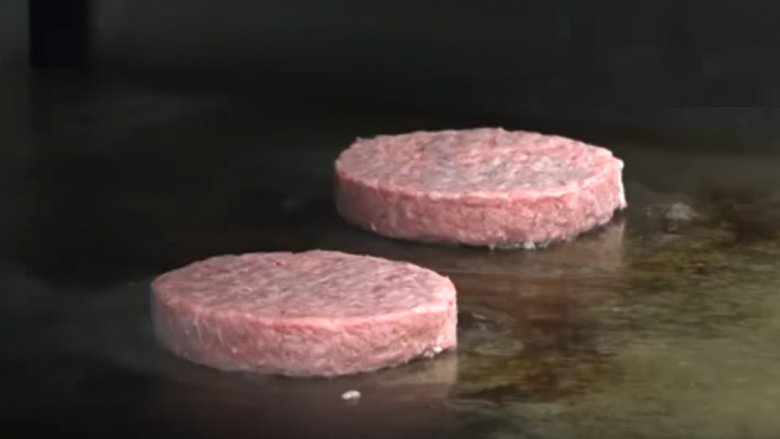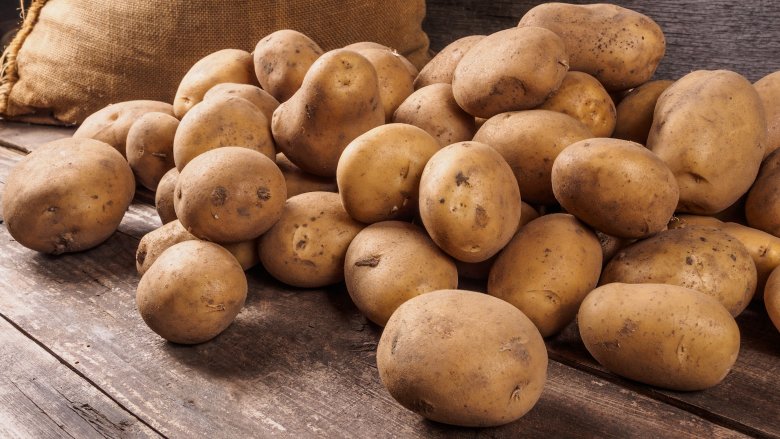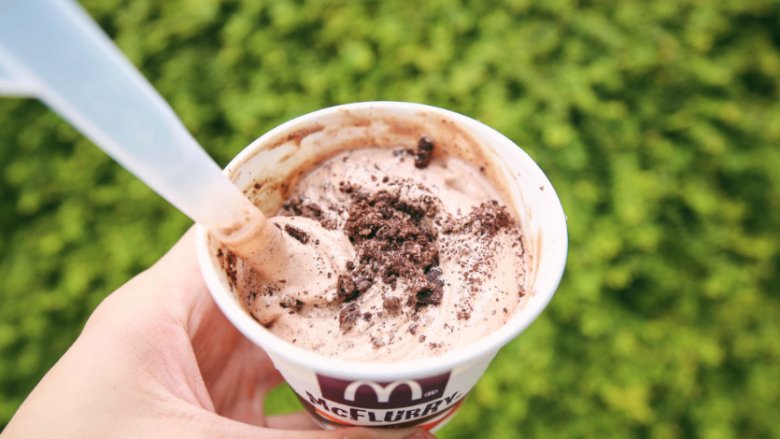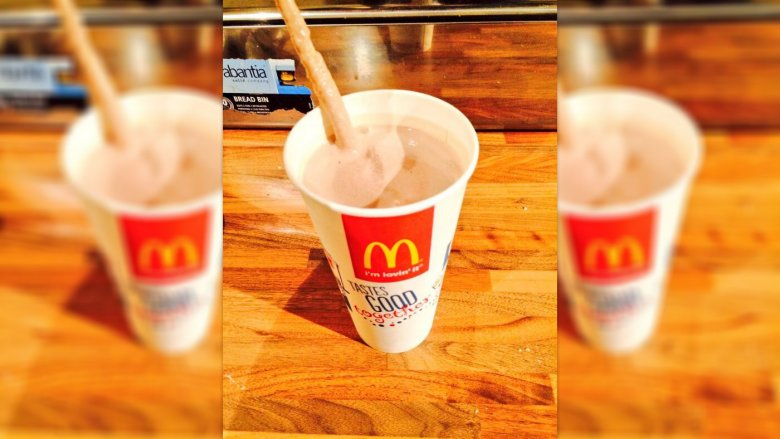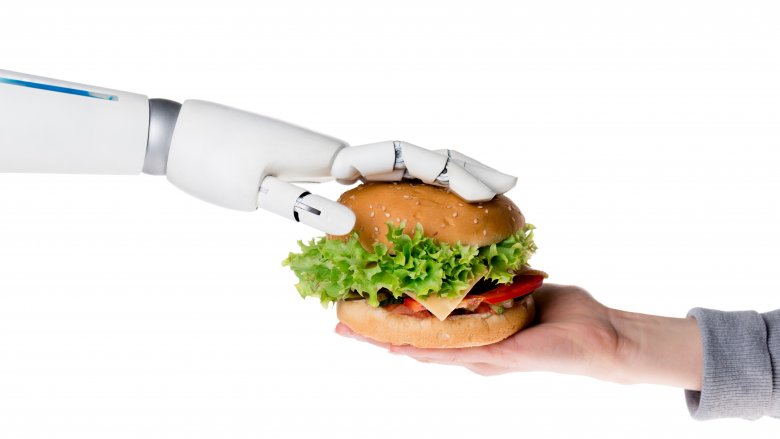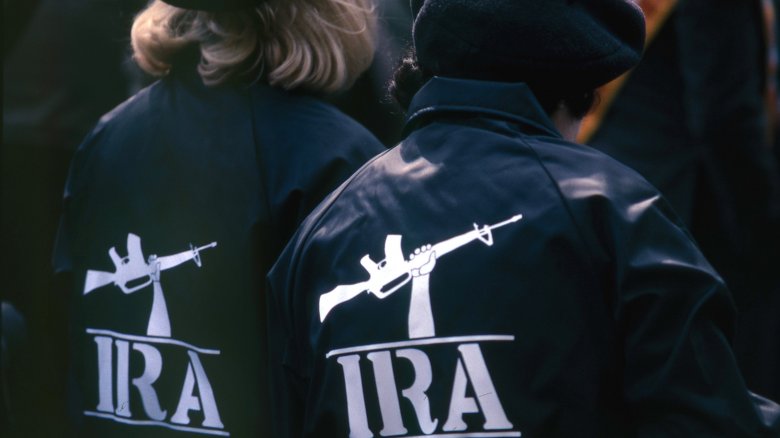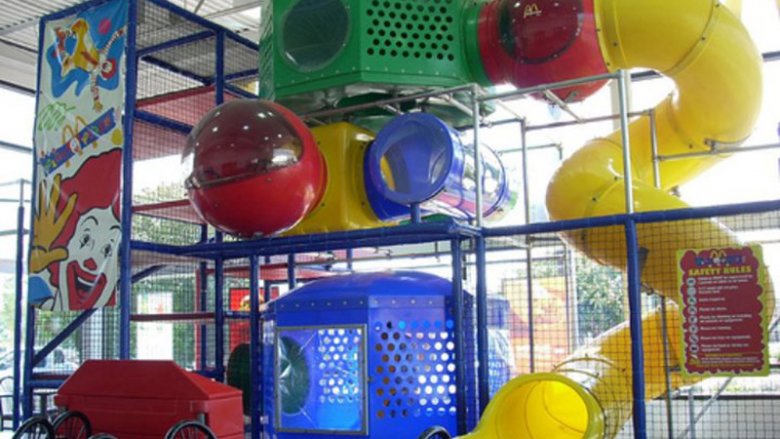False McDonald's Facts You Always Thought Were True
Love it or hate it, McDonald's is one of the most successful fast-food chains in the world and it's not going anywhere anytime soon. Known for its ubiquitous golden arches and convenient, greasy fare, McDonald's restaurants can be found in virtually every city and town in the United States, and in almost every country in the world. So it's practically inevitable that all kinds of rumors get spread about the burger juggernaut that people love — and love to hate.
From pink slime, to cow eyeballs, to indestructible food and collusion with corrupt governments across the world, here are some of the most abundant false facts about McDonald's that you always thought were true.
Ray Kroc started McDonald's
Ray Kroc is often referred to as the founder of McDonald's. And while he is responsible for its proliferation and unparalleled success, he's actually not the person who came up with the original concept. Rather, that credit belongs to Richard "Dick" and Maurice "Mac" McDonald, two brothers from New Hampshire who opened a barbecue restaurant in 1940. An innovative pair, they streamlined their restaurant to serve only burgers, shakes, and fries to customers in a fast, friendly manner for an inexpensive price with their "Speedee Service System." By 1954, they had built an extremely successful operation, as well as 21 franchises.
It was then that Ray Kroc, a milk shake mixer salesman, entered the picture. Impressed by their business model, and after opening a McDonald's franchise of his own, Kroc decided he wanted to purchase their entire franchise operation in 1961. The brothers, who were reluctant to get into the franchise business in the first place, sold him the business name and all, for $2.7 million. And over the years, Kroc turned it into the $100+ billion dollar fast-food empire that it is today, one franchise at a time.
The first McDonald's is located in Des Plaines, Illinois
If you ever find yourself in Des Plaines, Ill., you'll have the opportunity to visit the McDonald's #1 Store Museum, which according to Ray Kroc was the first-ever McDonald's restaurant. However, there's more to the story here, as there often is when it comes to McDonald's history. While it was the flagship franchise that Ray Kroc opened, it's not the first or even the second restaurant location — it's actually quite far down the list as the McDonald's brothers already had 21 franchises before Kroc even entered the picture.
Furthermore, the McDonald's building in Des Plains isn't even the original building; it's a replica of the restaurant that was torn down, but rebuilt once the company realized they needed to preserve their history. So where is the original, first restaurant located? It's in San Bernardino, CA, where the McDonald's brothers started their hamburger business back in 1940, years before Ray Kroc bought them out.
So while this was Ray Kroc's first franchise, it was most certainly not the first McDonald's.
The hot coffee lawsuit awarded the plaintiff over a million dollars
Ask most people what they know about the "hot coffee lawsuit" against McDonald's, and they'll say that a woman spilled hot coffee on herself while driving, and successfully sued for over a million dollars. Some folks might even suggest that the woman was just trying to get easy money, or that she was a scammer.
But the reality is actually quite different. Stella Liebeck, the plaintiff in Liebeck vs. McDonald's Restaurants, was not driving, nor was she a scammer. She was sitting in the passenger seat of a stopped car when she attempted to remove the lid off of a cup of coffee she had just ordered. The cup slipped, spilling scalding coffee (around 190 degrees Fahrenheit!) all over her, causing third-degree burns on her lap, buttocks, and genital area. Lieback was hospitalized for eight days, during which she had skin grafts and debridement treatments. She was permanently disfigured as a result of the accident.
Initially she only asked McDonald's for $90,000, but McDonald's countered with a paltry $800, so Liebeck rightfully sued. In the end, she was awarded an undisclosed amount (under $600,000) for her pain and suffering.
McDonald's fries are only made of potatoes
McDonald's sells approximately nine million pounds of french fries every day at its locations all over the world. But contrary to popular belief, McDonald's fries are not a one-ingredient wonder. And while spuds are the main ingredient, there are actually a total of 19 ingredients in their fries, including vegetable oil (comprised of canola, corn, soybean, and hydrogenated soybean oils, as well as milk- and wheat-derived natural beef flavoring), dextrose (for that golden, yellow color), sodium acid pyrophosphate (to prevent color changes when frozen), citric acid (for freshness), dimethylpolysiloxane (to reduce foaming), and salt (for flavor).
McDonald's employees make $45K a year in Denmark
Fast food restaurants like McDonald's have long been criticized for underpaying their workers, often starting employees at minimum wage. So in 2015, fast food workers around the country went on strike, demanding that the minimum wage be raised to $15 per hour.
And around that time, memes began to pop up, stating that McDonald's workers in Denmark all make $45,000 per year, in support of the protesters. And while they are unionized, and certainly paid better than most American workers (about $21 per hour), not all McDonald's workers in Denmark make that amount of money. This is because the majority of McDonald's workers in Denmark work part-time. So while full-time workers do make $45K, the majority of workers do not.
McDonald's treats its beef with ammonia
McDonald's has been plagued with a variety of rumors about their food over the years, specifically about their meats and animal products. And the rumor that McDonald's treats the beef it uses with ammonia, specifically because it uses select lean beef trimmings, is just that: a rumor. And while McDonald's did use select lean beef trimmings prior to 2011, they no longer do. As per their website, the burgers from Micky D's are 100 percent beef and not treated with any preservatives. The only treatment the beef is subjected to is being ground, shaped, and frozen for distribution; no chemicals are used.
Chicken McNuggets are made of pink slime
You've seen it: the images of what you think is strawberry ice cream at first, but instead it's "pink slime." And this pink slime, according to the rumors that flew around on the internet, is the base ingredient for Chicken McNuggets. Much like the rumor that beef is treated with ammonia, the scare logic is the same here.
In spite of the image, which is disturbing and quite compelling, McDonald's does not use "pink slime" in anything. A statement on their website notes that, "Let's set the record straight: this image in connection with McDonald's is a myth. In fact, we don't know where it came from, but it's not our food." So until anyone proves otherwise, the "pink slime" rumor is completely false.
Dubious meat and fillers
Another set of rumors suggest that McDonald's has used a variety of questionable meat and fillers in their food. In one case, a satire article that said both human and horse meat were found in McDonald's meat factories in Oklahoma (and elsewhere) was taken at face value by some gullible folks. They've also long been plagued by the rumor that they use worms as filler, which Ray Kroc dismissed, noting that worms are more expensive than beef to source. But the rumors persist, as evidenced by the hits you get on a Google search. They've even been accused of using cow eyeballs in their burgers, and "mutant laboratory meat," too.
But none of these accusations are true. Again, McDonald's burgers are made of 100 percent beef with no fillers, extenders, or preservatives.
No one outside of the company knows what is in the secret Big Mac sauce
The Big Mac, McDonald's signature burger, like many of McDonald's best-selling menu items, was invented by a franchisee; Jim Delligatti came up with the idea 50 years ago. Comprised of "two all-beef patties, special sauce, lettuce, cheese, pickles, onions on a sesame-seed bun," the iconic burger is the world's best-selling sandwich — approximately 550 million are sold and eaten every year.
The so-called special sauce has long been rumored to have a secret recipe that only folks in the company know about. But that's not the case — in fact, you can find the ingredients for the special sauce on their website. And there are plenty of copy-cat recipes out there, too, should you want to make a Big Mac at home.
McDonald's food doesn't decompose
Over the years there have been quite a few viral posts from folks who have allegedly purchased a McDonald's meal, then preserved it for years after purchase. The result has been that these meals don't appear decompose or amass mold, feeding the myth that McDonald's food is so pumped full of preservatives and additives, or simply just not food at all, that it doesn't decay in the manner that it should.
But the reality is the reason these foods don't rot isn't because they are unhealthy, but because of the controlled conditions in which they were stored, photographed, and documented. In fact, any food preserved or stored without moisture will wither and dry up, subsequently not showing regular signs of decomposition. And that's the case with each of these preserved meals — they simply dried up.
Molten copper rolls off of McDonald's burgers because they're indestructible
Upon first view, this video had everyone reeling.
Why would food, when covered in molten, scalding metal, deflect it? How is this not a bad thing? The internet certainly had reactions, puzzled as to why food could defy liquid metal. And the takeaway was that McDonald's burgers, since they clearly are indestructible, must in turn be indigestible.
But this phenomenon is not unique to food prepared by McDonald's; the same thing happens when you pour molten copper over any food. This is because of the Leidenfrost effect, which is defined as "a phenomenon in which a liquid, in near contact with a mass significantly hotter than the liquid's boiling point, produces an insulating vapor layer keeping that liquid from boiling rapidly." In essence, the water in the Big Mac boiled the second the molten copper hit it, and that steam insulated the burger from the hot metal.
You can see molten copper poured on a host of other objects here.
McDonald's had a suggestive image on their holiday cups
Back in December of 2016, McDonald's debuted some new, seasonal cups to commemorate the holiday season. They looked innocent enough, featuring a pair of mittens on a festive, holiday-themed background. However, a viral Tweet emerged featuring a slightly doctored version of the cups, making the image look obscene. And some folks thought this was deliberate on behalf of McDonald's.
But no, as funny as it was, it was not intentional. A representative from the company told the Huffington Post, "The altered image circulating on social media is the result of someone getting a little cheeky and adding some hand-drawing to a cup."
They buy their beef from a company called 100% Beef
It's not easy being a giant in the hamburger biz, and McDonald's has been dodging rumors about its beef for years. One of the rumors that began circulating around the internet a few years ago alleged that McDonald's masterminded a plan to trick its customers into believing soy/beef combo patties were 100 percent beef by buying the bogus meat from a company called... 100% Beef. According to the rumors, this gave McDonald's the ability to say they use 100% beef, when that was really nothing more than a play on words.
McDonald's has made an effort to stamp out this rumor, releasing a statement that read in part: "We've heard this myth, and can confirm that '100% beef' 'is not a company owned by McDonald's. We refer to '100% beef' when describing our beef burgers because these are made from whole cuts of beef, taken from the forequarter and flank, which are simply minced and shaped into burger patties."
While the company assures its customers that the only thing added to patties is "a sprinkling of salt and pepper," consumers can rest easy on more than just the word of McDonald's. Truth in advertising laws simply are not lax enough to allow a major corporation to find such a loophole. The Federal Trade Commission was put in place to prevent exactly this sort of deception.
Their fries contain beef
We're not even going to try contemplate how many orders of fries McDonald's has sold over the years, but it's probably some comically obscene number like a zillion trillion billion. Regardless, when you have the most popular french fry on the planet, people begin to ask questions and it doesn't take long for the rumor mill to start turning.
One of those rumors is that McDonald's french fries contain beef. How true this is all depends how you look at the chemistry. In 1990, McDonald's announced they would only be using pure vegetable oil in the fry making process, but then they were sued by vegetarians who claimed they used beef in their fries. McDonald's eventually settled the lawsuit to the tune of $10 million because the fries contained "natural beef flavoring." Since then, McDonald's fries have widely been believed to contain beef, and therefore be non-friendly to vegetarians and vegans.
So what is "natural beef flavoring" and is it vegetarian-friendly? Well, the beef flavoring is created by adding sugars and citric acid to the amino acids found in beef. Eater explained like this: "Once a flavor is broken down into its basic chemical components, scientists can reconstruct it and add one food's flavor to another, creating that umami-like, 'meaty' taste without the beef."
Still, because of the FDA's incredibly relaxed rules surrounding natural flavorings and their disclosures, we may never know what's really in those fries.
McDonald's uses toxic potatoes
Run for your life, it's the attack of the toxic potatoes! Or is it? Nobody wants to eat fries made from potentially toxic potatoes, and thankfully, this isn't the case with McDonald's.
The rumor mill began churning with this idea in 2014, after food author Michael Pollan launched a video attack against McDonald's for being too picky with its potato size. Pollan said that because McDonald's required potatoes to be of a certain size and shape and couldn't have any blemishes caused from aphids, pesticides were a must. Pollan described farmers spraying their crops with poisons and storing them away for weeks because immediately shipping them out would be too dangerous.
While some of Pollan's accusations were true, it was more how he framed them that resulted in headlines like "You'll Never Eat McDonald's French Fries Again." McDonald's does have size requirements for its potatoes, but the others don't go in the trash. They're simply resold by the farmers. They also try to avoid potatoes that have the aphid-caused "net necrosis," because frankly, black streaks in fries are gross. Finally, the farmers don't hide the potatoes away for weeks because they're toxic bombs, but because the large sheds are climate-controlled so you can have fries January through December.
Their ice cream treats are dairy-free
If you're worried that your ice cream from McDonald's isn't dairy at all, we're here to crush that myth. Rumors have alleged that McDonald's dropped the "milk" from milkshakes on their menu, because they're not dairy at all. Hogwash!
The reason they call them "shakes" on the menu is because each state has different dairy regulations "on what can officially be called a milkshake." (Some states take their milkshakes very seriously.) "Our shakes contain milk from our reduced-fat, soft serve, which makes them thick and creamy," a McDonald's spokesperson said.
A similar finding is true for the fast food chain's soft serve, according to a company statement. Their soft serve is actually "ice milk" rather than ice cream, because it has a lower milkfat content to make it lighter. "Ours is made using milk and cream from Canadian dairies," read part of McDonald's Canada's statement.
Considering that the McFlurry is made using the soft serve, the frozen treat is most certainly not vegan-friendly, despite what you might have read. Yes, it appears for now you'll just have to skip those shakes and McFlurries altogether or embrace the dairy guilt that comes with them.
The milkshakes are made with pig fat
McDonald's must have a person solely dedicated to clearing up rumors about its ice cream, because the myths just won't die. We already dispelled the rumor that there wasn't any dairy in the shakes and soft serve, but there's still the issue that they contain plastic and even worse — pig fat!
How these rumors ever got started isn't entirely known, but they seem to be prevalent enough that McDonald's has felt the need to comment on them. McDonald's corporate and franchise owners themselves have assured the public that the only animal products in their frozen treats are dairy, not pig or chicken fat.
As for the rumor that plastic is in the shakes, that one apparently started when a writer said he spoke with a "scientist" while waiting in line who told them the shakes were sugar-infused plastic. Fortunately, no credible source has ever backed up this statement. What the shakes do contain is carrageenan, which is derived from a type of seaweed and used to make sure your milkshake isn't an undrinkable crystallized frozen block.
Just to clarify, you don't have to worry about sucking down pork fat or plastic in your McDonald's shake, just a lot of sugar.
It has a location run entirely by robots
While a fast food restaurant run entirely by robots may not be terribly far off in the future, it's not a reality at any McDonald's in the US just yet. That didn't stop a story perpetuating the idea that robots had taken over an Arizona McDonald's from spreading across social media in 2015 though.
After a fake news site ran a story titled "New McDonald's In Phoenix Run Entirely By Robots," it was circulated across Twitter. It probably didn't help matters that the story wasn't written in a particularly satirical way and even referenced a CNN story that talked of the possibility of robots replacing fast food workers.
Despite the completely made up quotes and non-existent restaurant opening, numerous people on social media circulated the phony story. Even a year later, shareholders had to be assured by McDonald's CEO Steve Easterbrook that robot workers were not about to take over.
McDonald's was funding a European terrorist group
In the late 1980s, Northern Ireland was embroiled in political violence and rumors began to fly that the Golden Arches was funneling cash to support the Irish Republican Army, a group that had been linked to numerous shootings and car bombs. Weird, right?
At the time, McDonald's could never trace exactly how the rumor started, and made numerous efforts to deny that it had any links or affiliation with the IRA. After all, it would be really messed up to have a menu item called a Happy Meal and then use the profits to fund a terrorist group. So how did such a nasty rumor ever come to exist?
It all boiled down to a miscommunication involving retirement funds and satellite TV. It started when CNN mentioned in a story that McDonald's had made generous donations to its employees' individual retirement accounts or IRA. In the UK, IRA meant something completely different, and when the story was broadcast overseas, people took it to mean that Ronald McDonald was handing over cash to the Irish Republican Army.
They converted Colorado PlayPlaces into pot lounges
It's pretty evident that McDonald's is making an effort to convince people it's more grown up. Its McCafe is competition to Starbucks, and the once abundant PlayPlaces are all but extinct. Just because the PlayPlaces are going away that doesn't mean McDonald's is all of a sudden entering its teenage rebellion years. We're talking about the social media rumor that Colorado locations had plans to replace them with weed-smoking lounges. Sorry, stoners, it's not happening.
McDonald's spokesman Khim Aday told the Associated Press that he could "confirm 100 percent that this is not true." The story started in 2015 when the fake Now 8 News site ran a story that numerous Colorado restaurants had either completed or where planning to create pot pods so that customers could take bong rips without disturbing other guests.
Colorado may have legalized recreational marijuana use in 2014, but openly lighting up in a McDonald's — or any restaurant for that matter — is still an illegal buzzkill.
